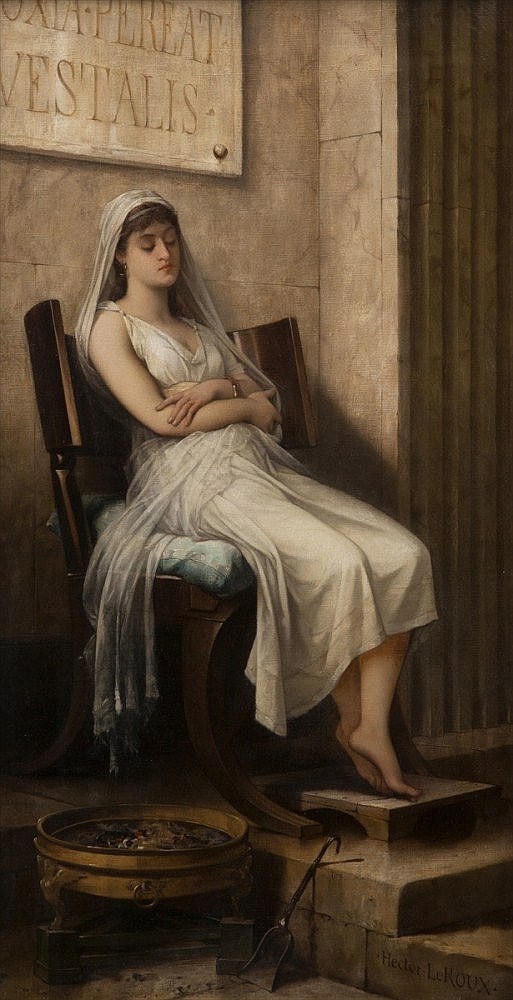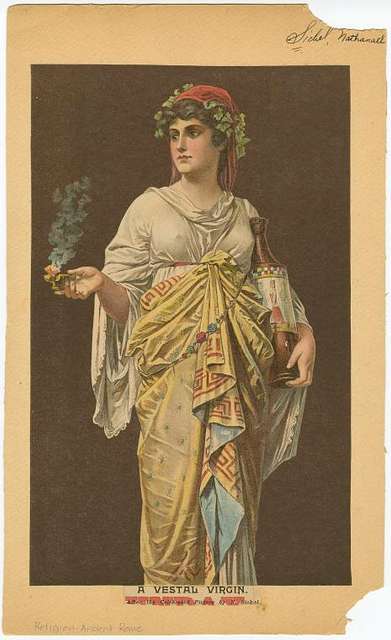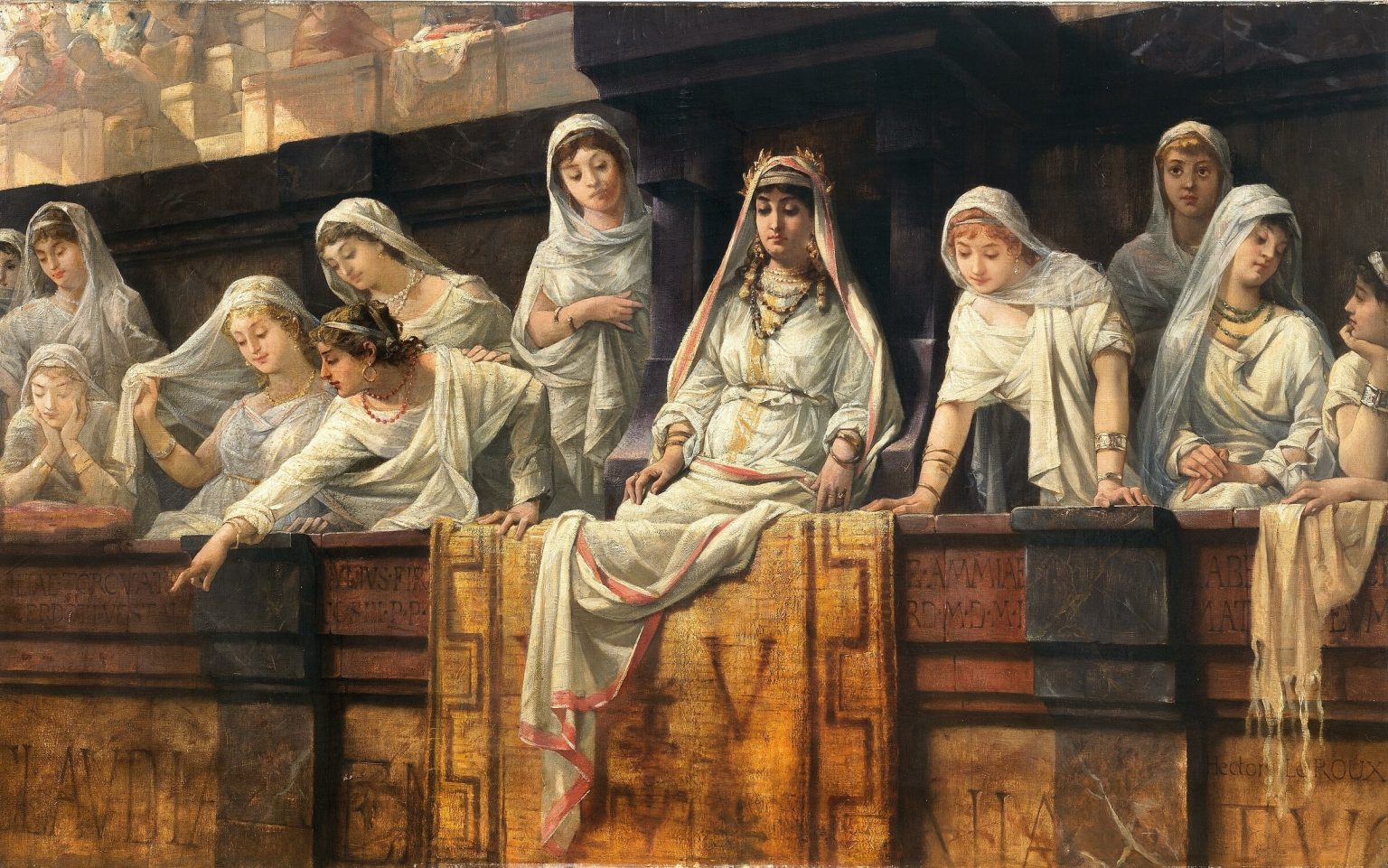In the heart of ancient Rome, the Vestal Virgins held a position of unparalleled significance. These priestesses, dedicated to the goddess Vesta, were more than just religious figures; they were symbols of purity, continuity, and the very heart of Roman society. Their role has been a subject of fascination and debate for historians, with some viewing their position as a religious honour and others as a manifestation of patriarchal control. As we journey through this historical landscape, we’ll explore both perspectives, shedding light on the intricate tapestry of ancient Roman culture.
Vestal Virgins: A Religious Necessity and Honour
The Vestal Virgins were chosen from noble families at a young age, typically between six and ten, and were tasked with maintaining the sacred fire of Vesta, the goddess of the hearth. This fire symbolized the eternal life of Rome, and its continuity was paramount. The Vestals’ role was, therefore, of utmost importance.
The advantages of this perspective are clear. The Vestals were given immense privileges. They were the only women in Rome who could own property, they had the best seats at public games, and they were free from the usual societal expectations of marriage and childbirth. Their chastity was seen as a direct conduit to the gods, granting them a unique spiritual authority.
However, this perspective isn’t without challenges. The Vestals’ vow of chastity was a double-edged sword. While it granted them certain freedoms, it also came with severe penalties for transgressions. A Vestal found to have broken her vow could face dire consequences, including being buried alive. This strict code of conduct raises questions about the true nature of their ‘honor.’

Vestal Virgins: A Tool of Patriarchal Control
While the Vestals’ religious duties and privileges are undeniable, there’s another perspective that cannot be ignored. Some historians argue that the Vestal Virgins were a tool of patriarchal control, a means to subjugate women under the guise of religious duty.
This perspective highlights the strict regulations surrounding the Vestals. Their lives were not their own; they were bound by a 30-year vow of chastity, with a third of their lives dedicated to learning, a third to serving, and a third to teaching. Their very existence was centered around their virginity, a trait highly valued by the patriarchal Roman society.
The advantage of this viewpoint is that it challenges the romanticized notion of the Vestals and offers a more critical lens through which to view their role. However, it also faces challenges. Some might argue that this perspective diminishes the genuine religious and societal importance of the Vestals, reducing them to mere pawns in a male-dominated society.
Conclusion: The Dual Legacy of the Vestal Virgins
The Vestal Virgins, with their enigmatic presence, represent both the spiritual heart of Rome and the complexities of gender roles in ancient societies. Whether viewed as religious icons or symbols of patriarchal control, their legacy is undeniably intertwined with the very fabric of Roman history. As we reflect on their role, we are reminded of the multifaceted nature of history, where perspectives shift and evolve, but the quest for understanding remains eternal
The Intricate Lives of the Vestal Virgins: A Glimpse into Ancient Rome’s Sacred Priestesses
In the bustling heart of ancient Rome, amidst grand temples and bustling marketplaces, the Vestal Virgins led lives that were both privileged and constrained. Their existence, deeply rooted in religious traditions, offers a captivating insight into the societal and spiritual fabric of the Roman Empire.

Selection and Early Years
The journey of a Vestal Virgin began with her selection. Chosen from noble families between the ages of six and ten, these young girls were picked based on specific criteria, including their health, absence of physical defects, and the status of their families. Once chosen, they were whisked away from their families to the Atrium Vestae, the House of the Vestals, located near the Roman Forum.
Their initial years were dedicated to learning – understanding the intricate rituals, the significance of the sacred fire of Vesta, and the myriad duties they would soon undertake. This period was crucial, as the sacred fire they would tend symbolized the eternal life of Rome. Its continuity was paramount, and the Vestals were its guardians.
Duties and Daily Life
The core duty of a Vestal was to maintain the sacred fire of Vesta. This was no small task; the fire’s extinction was considered an omen of impending disaster for Rome. Beyond this, they were also responsible for various religious ceremonies, preparing ritual food, and safeguarding sacred objects.
Their daily life was a blend of religious duties and privileges. They were the only women in Rome who could own property and were free from the societal expectations of marriage and childbirth. They enjoyed the best seats at public games and were revered by many. However, their revered status came with a price: a strict vow of chastity. This 30-year vow was divided into a decade of learning, a decade of service, and a decade of teaching the next generation.
Challenges and Consequences
While the Vestals enjoyed certain freedoms, their lives were not without challenges. The weight of their responsibilities was immense. Any negligence, especially letting the sacred fire extinguish, could lead to severe punishments. More daunting was the penalty for breaking their vow of chastity – a fate that involved being buried alive.
Legacy and Significance
The Vestal Virgins, with their unique blend of duties, privileges, and challenges, left an indelible mark on Roman history. They were more than just priestesses; they were symbols of Rome’s spiritual and societal values.

The Tragic Tale of Vestal Virgin Tuccia: A Test of Innocence in Ancient Rome
In the annals of Roman history, the Vestal Virgins were revered figures, their chastity and dedication to the goddess Vesta of paramount importance. Yet, amidst tales of honor and duty, there lies the poignant story of Tuccia, a Vestal Virgin whose virtue was put to the test in a dramatic display of faith and resilience.

The Accusation
Tuccia, like her fellow Vestals, had taken a solemn vow of chastity. However, rumors began to swirl around Rome that Tuccia had engaged in a forbidden relationship. Such accusations were not taken lightly; the consequences for a Vestal found guilty of breaking her vow were dire, often leading to a gruesome death.
The Divine Test
Desperate to prove her innocence, Tuccia turned to the gods. She prayed to Vesta, seeking a way to demonstrate her purity to the people of Rome. Legend has it that Vesta answered her prayers by granting her the ability to perform a miracle.
The next day, in front of a gathering crowd, Tuccia approached the Tiber River. With a sieve in hand, she began to scoop water from the river. To the astonishment of all present, the water did not leak through the sieve. Tuccia managed to carry the sieve full of water all the way to the Temple of Vesta without spilling a drop. This miraculous feat was seen as a divine sign of her innocence.
The Aftermath
The people of Rome, having witnessed this divine intervention, were convinced of Tuccia’s purity. The accusations against her were dropped, and her honor was restored. However, the emotional scars from the ordeal remained. Tuccia’s story serves as a testament to the immense pressure and scrutiny the Vestal Virgins faced, where even a whisper of impropriety could lead to dire consequences.
1. How were the Vestal Virgins chosen, and what criteria were considered during their selection?
The Vestal Virgins were typically chosen from noble families when they were between the ages of six and ten. The selection process was rigorous, with several criteria in play. The girls needed to be in perfect health, free from physical defects, and without a history of disease in their family. Additionally, both their parents had to be alive, and the girl herself should never have been a slave or involved in any scandal. The Pontifex Maximus, the chief priest, would usually make the final selection.
2. What role did the Vestal Virgins play in Roman festivals and ceremonies?
The Vestal Virgins played pivotal roles in various Roman festivals and ceremonies. One of the most significant was the Vestalia, a festival dedicated to Vesta, where the inner sanctum of her temple was opened for Roman matrons to offer sacrifices. The Vestals also participated in the Parilia, a festival for the purification of sheep, and the Fordicidia, which involved the sacrifice of pregnant cows. Their presence was essential in ensuring the rituals were performed correctly and that the gods were appeased.
3. How did the attire of the Vestal Virgins differ from other Roman women?
The Vestal Virgins wore distinctive attire that set them apart from other Roman women. They donned a white, woolen dress called a “stola,” symbolizing purity. Over this, they wore a draped, rectangular cloth called a “palla.” Their most distinctive feature was the “infula”, a white, woolen headdress, and the “vittae”, ribbons that hung down from it. This attire not only signified their sacred status but also their commitment to chastity and service to Vesta.

4. Were there any instances where the Vestal Virgins intervened in political matters?
While the primary role of the Vestal Virgins was religious, there were instances where they indirectly influenced political matters. Due to their revered status, they often served as intermediaries or were sought for blessings. One notable instance is when Julius Caesar, as a young man, was saved from Sulla’s purges because the Vestal Virgins interceded on his behalf, emphasizing his family’s dedication to Rome and its gods.
5. How did the role and perception of the Vestal Virgins change as Rome transitioned from a Republic to an Empire?
As Rome transitioned from a Republic to an Empire, the role of the Vestal Virgins underwent subtle changes. While they retained their religious significance, emperors often used them as symbols of the empire’s continuity and stability. Their presence was leveraged to legitimize the rule of certain emperors. However, as Christianity began to take hold in the later stages of the Roman Empire, the importance and influence of the Vestal Virgins waned, eventually leading to the dissolution of their order in the late 4th century AD.



